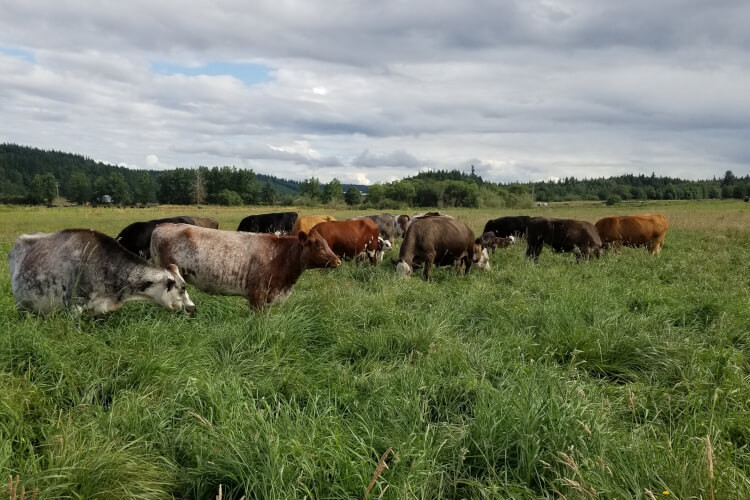Beef Stew Cooking Guide (Recipe)
posted on
January 2, 2024

Did you know?
If you cook beef stew meat for too long you can dry it out.
You spend hours chopping vegetables and cooking a soup that looks and smells delicious.
Then you take a bite and the meat is dry. What?
It seems like an oxymoron that your meat can be dry when it’s submerged in liquid, but unfortunately it’s all too possible.
And so disappointing.
But it doesn’t have to be that way!
When your stew meat is all dried out and flavorless, it's because you cooked it too long. Stew seems like the sort of thing you should boil all day, but really you just want to get the beef to fork tender - 2 hours or so should do the trick.
So if you're ready to make a fantastic beef stew, read on.
With a few simple tips and tricks, you can make a delicious stew with fork-tender bites of beef every time.
And that’s great news because beef stew is such a comforting, nourishing, easy meal that also gives you a little break by making lovely leftovers. It freezes well, too, if you want to put away some emergency meals for a rainy day.
It’s tasty and flexible, too. Pretty much anything you have in the fridge or on the pantry shelf can go in the pot. And it will taste different every time, too, because you can change up the herbs and spices with nearly infinite variation.
And I love that it’s a dish you can make with nearly all local ingredients. We’ve got the beef, of course. For a starchy addition, you can get potatoes, squash, wheat berries, and even pasta (local grain, locally milled). And so many different vegetables. All from Jefferson County Farmers. What a delicious paradise we live in!
There are so many great recipes you can follow, but what I usually do is follow more of a method than a recipe. I’ve included those guidelines here so you can create your own beef stew masterpiece with whatever you have.
What my grandmother would say about that is “just make it work.” Good advice, and delicious, too.
If you'd rather follow a specific recipe, try this Japanese Style Beef Stew. It has a unique flavor profile that we find irresistible.
Here are the basic steps to making a classic Beef Stew.
- Cut your stew meat into bite size pieces (at our house with small children, that’s 1” cubes).
- Brown it a bit in a preheated kettle in some oil. Don’t worry if it’s not all browned all over. I like to use 2 lbs of beef stew meat, which crowds the kettle a bit. So usually only the first side down gets browned because the meat starts to release juices. But it still turns out fantastic. Feel free to brown your meat in small batches if you want a uniform browned effect all the way around.
- Throw in some chopped vegetables – I always use onion and carrots, then add whatever else is languishing in the fridge. Swiss chard or green beans are good. Perhaps add potatoes, though you can choose to add these after 45 minutes of simmer time so they stay a bit firmer.
- Add a can of tomatoes for a punch of acid to kick the flavor up a notch.
- Toss in some seasonings. It’s hard to go wrong with a bay leaf, pepper and some thyme.
- Cover it all with liquid. I like to use partial jars of leftover broth from previous meals and then add water as needed. It doesn’t have to be beef broth – it really doesn’t matter what type of broth, and it can even be a mix. Chicken, pork, or vegetable are all good. Use bone broth if you have it for extra nutrition.
- Perhaps fancy it up with a splash of wine or beer if you’re feeling adventurous. Worcestershire sauce is a classic addition and can be nice. Balsamic vinegar gives a similar depth of flavor, with more sweetness. Only use 1 or 2 T at most of those flavor-packed sauces, and I don’t use them if I’ve added wine or beer. Just pick one…
- Partially cover with a lid and simmer until the meat is tender. With One Straw beef, for 1” cubes that’s usually about 1.5 hours. For bigger cubes, you’ll want closer to 2 hours for the perfect tender bite. If adding potatoes, add them when there’s about 30-45 minutes left. You can add more tender options like greens at this time, too. Think chopped kale or zucchini.
- Season with salt. Since the quantity depends on what cooking liquid you used, I hate to hazard a guess here.
- If you didn’t add potatoes, Beef Stew goes great served over cooked pasta.
- Last week, instead of potatoes or pasta, I added ¾ cup of whole wheat berries, grown right here in Chimacum by Chimacum Valley Grainery. I added the wheat when there was about 1 hour left of simmer time, and they came out perfectly plump with just the right amount of chew.
- Cooked kidney beans or garbanzo beans are also a favorite addition. Add them in towards the end of cooking time to get them simmering in the flavor without getting too mushy.
MMMMM. So comforting, and having a nice jar of leftovers for lunch (or another dinner!) leaves more time for relaxing and enjoying life.
And there are so many variations on the theme, whether by design or by just using whatever happens to be leftover in the larder.
One of my great aunts used a turnip and an apple in her family-famous stew…
Whatever your favorite “secret ingredients” for beef stew, it’s always a great time of year to get a pot simmering on the stove.
Click here to order Beef Stew Meat





